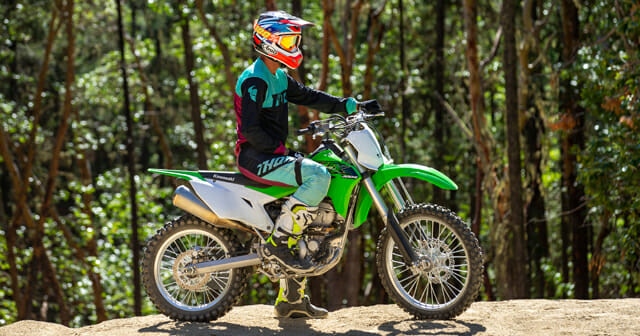My son and I had 2 - KX250F's 2017 year and they run perfect and strong. He traded his for a 450cc 2015 , after the first ride noticed some steam and stopped. I filled the coolant 50-50 , as the coolant level was only 15% filled. Within 5 minutes of riding and 2-3 minutes of idle the coolant boils out.
At night the exhaust pipe was starting to faintly glow. First thought was the bike is running too lean and heating up.
Performed the following checks and changes, still overheats same as before.
new Oil
new Filter for oil and air
new Coolant 50-50
adjusted TPS sensor to top level of spec voltage to run richer, not lean.
idle and WOT both within range.
Regardless of this setting, still overheats on the low range and high range of TPS voltage.
Note: running higher voltage range - rich - no glowing exhaust pipe which is good.
Compression tested to 70PSI
Pressure test for Radiator - 20+ PSI - no leak down.
checked water pump flow, disconnected a water pipe, started bike and it flowed very well.
Oil pump, looked in inspection window and there appears to be movement. - Need a better Oil Flow test procedure.
Installed Spark Plug gap to .035
idle is exact at 2000, RPM. New Tachometer.
New Chain guards and adjusted chain slack.
No ECM codes stored, testing with harness power - and light.
cautious about the slight dent on the exhaust system. 1/4" dent. Going to wrap exhaust with heat sheild. Exit exhaust temp 800F on pipe.
Most of the bike motor is about 180F max
highest temp is on exhaust pipe exit from cylinder head.
Swapped radiator cap
Change to the BLACK ECU connector , less aggressive at 0-25% throttle.
Valve clearance in spec.
I am at a loss.
Bike at idle will boil in 3 minutes and lose 80% of the coolant if we let it keep dumping coolant.
Any guidance is appreciated.
At night the exhaust pipe was starting to faintly glow. First thought was the bike is running too lean and heating up.
Performed the following checks and changes, still overheats same as before.
new Oil
new Filter for oil and air
new Coolant 50-50
adjusted TPS sensor to top level of spec voltage to run richer, not lean.
idle and WOT both within range.
Regardless of this setting, still overheats on the low range and high range of TPS voltage.
Note: running higher voltage range - rich - no glowing exhaust pipe which is good.
Compression tested to 70PSI
Pressure test for Radiator - 20+ PSI - no leak down.
checked water pump flow, disconnected a water pipe, started bike and it flowed very well.
Oil pump, looked in inspection window and there appears to be movement. - Need a better Oil Flow test procedure.
Installed Spark Plug gap to .035
idle is exact at 2000, RPM. New Tachometer.
New Chain guards and adjusted chain slack.
No ECM codes stored, testing with harness power - and light.
cautious about the slight dent on the exhaust system. 1/4" dent. Going to wrap exhaust with heat sheild. Exit exhaust temp 800F on pipe.
Most of the bike motor is about 180F max
highest temp is on exhaust pipe exit from cylinder head.
Swapped radiator cap
Change to the BLACK ECU connector , less aggressive at 0-25% throttle.
Valve clearance in spec.
I am at a loss.
Bike at idle will boil in 3 minutes and lose 80% of the coolant if we let it keep dumping coolant.
Any guidance is appreciated.





